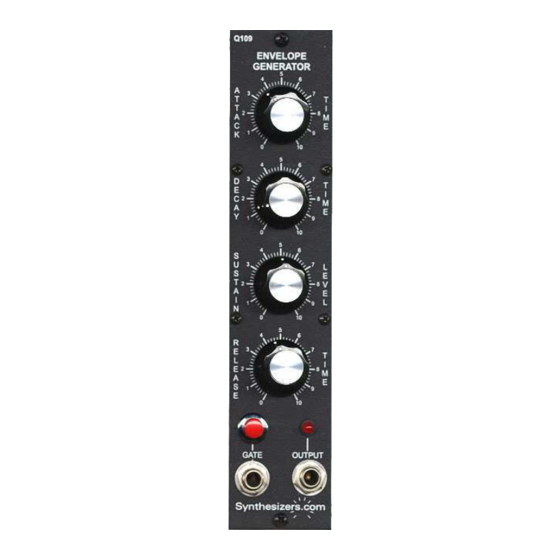
Table of Contents
Advertisement
Quick Links
Q109
Envelope Generator
Aug 2014
The Q109 Envelope Generator is one of the basic modules every synthesizer
must have. It generates a voltage envelope in response to a gate signal from a
keyboard, oscillator or other source. The envelope is used to control amplifiers,
filters, oscillators and other modules. The operator has complete manual control
over Attack time, Decay time, Sustain level, and Release time. A manual gate
button can be used to trigger the Envelope Generator at any time, and an LED
gives a visual indication of the output level.
Specifications
Panel Size: Single width 2.125"w x 8.75"h.
Attack Time Range: 1ms - 7+ seconds
Decay Time Range: 1ms - 12+ seconds
Release Time Range: 1ms - 12+ seconds
Sustain Level Range: 0-5 volts
Output Level: 0-5 volts
Gate Threshold: 1.5 volts
Power: +15V@30ma, -15V@30ma, +5@5ma.
Waveforms
Advertisement
Table of Contents

Subscribe to Our Youtube Channel
Summary of Contents for Synthesizers.com Q109
- Page 1 Envelope Generator Aug 2014 The Q109 Envelope Generator is one of the basic modules every synthesizer must have. It generates a voltage envelope in response to a gate signal from a keyboard, oscillator or other source. The envelope is used to control amplifiers, filters, oscillators and other modules.
- Page 2 Q109 Envelope Generator Aug 2014 This controls the length of the Attack phase of the envelope. The Attack phase goes from 0 to 5 volts. This controls the length of the Decay phase of the envelope. This controls the The Decay phase drops to...
- Page 3 Combining Delayed Envelopes to Create Complex Patterns Using 2 Q109's, trigger one from an unmodified gate signal (possibly from a keyboard or sequencer), and also patch the gate into a Q105 to create a delay for the second Q109. Combine the outputs of the 2...
- Page 4 Q109 Envelope Generator Aug 2014 Calibration and Testing Power Connector This module requires no calibration. 6 pin .1” MTA type connector made 1. Turn the Attack, Decay and Release controls to 0. by AMP. Available from Mouser 2. Apply a 10hz 10v PP square wave to the Gate input.







Need help?
Do you have a question about the Q109 and is the answer not in the manual?
Questions and answers